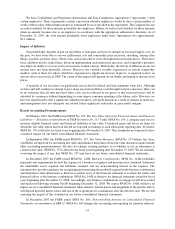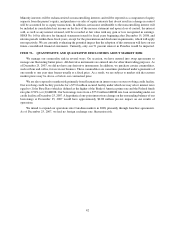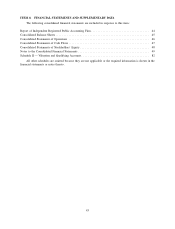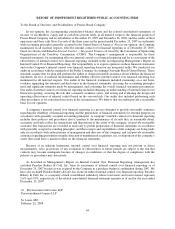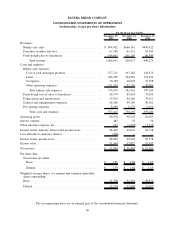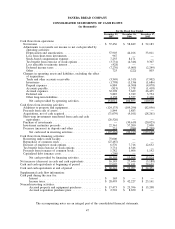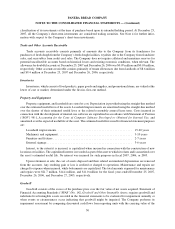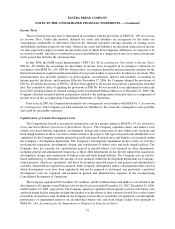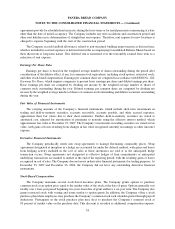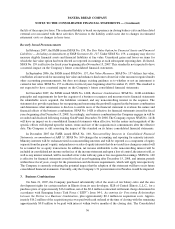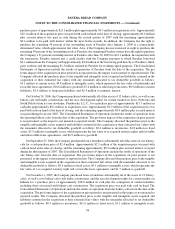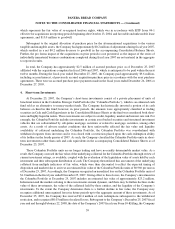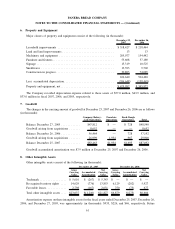Panera Bread 2007 Annual Report Download - page 61
Download and view the complete annual report
Please find page 61 of the 2007 Panera Bread annual report below. You can navigate through the pages in the report by either clicking on the pages listed below, or by using the keyword search tool below to find specific information within the annual report.underlying net assets inclusive of goodwill. The Company completed annual impairment tests as of the first day of
the fourth quarter of fiscal years 2007, 2006, and 2005, none of which identified any impairment.
Other Intangible Assets
Other intangible assets consist primarily of the fair value of favorable lease agreements, re-acquired territory
rights, and trademarks. The Company amortizes the fair value of favorable lease agreements over the remaining
related lease terms, which range from approximately 2 years to 18 years. The fair value of re-acquired territory
rights was based on the present value of bakery-cafe cash flow streams. The Company is amortizing the fair value of
re-acquired territory rights over the average remaining useful life of 13 years to 20 years. The fair value of
trademarks is amortized over their estimated useful life of 22 years.
The Company reviews intangible assets with finite lives for impairment when events or circumstances indicate
these assets might be impaired. The Company tests impairment using historical cash flows and other relevant facts
and circumstances as the primary basis for an estimate of future cash flows. As of December 25, 2007, no
impairment of intangible assets with finite lives has been recognized. There can be no assurance that future
intangible asset impairment tests will not result in a charge to earnings.
Impairment of Long-Lived Assets
The Company evaluates whether events and circumstances have occurred that indicate the remaining
estimated useful life of long-lived assets may warrant revision or that the remaining balance of an asset may
not be recoverable. When appropriate, the Company determines if there is impairment by comparing anticipated
undiscounted cash flows from the related long-lived assets of a bakery-cafe or fresh dough facility with their
respective carrying values. If impairment exists, the amount of impairment is determined by comparing anticipated
discounted cash flows from the related long-lived assets of a bakery-cafe or a fresh dough facility with their
respective carrying values. In performing this analysis, management considers such factors as current results,
trends, future prospects, and other economic factors. The Company recognized an impairment loss of $0.1 million
in fiscal 2007 related to one underperforming Company-owned bakery-cafe in the normal course of business. This
loss was recorded in other operating expenses in the accompanying Consolidated Statements of Operations. No
impairment of long-lived assets was determined for fiscal 2006 or 2005.
Self-Insurance Reserves
The Company is self-insured for a significant portion of its workers’ compensation, group health, and general,
auto, and property liability insurance with varying deductibles of as much as $0.5 million of individual claims,
depending on the type of claim. The Company also purchases aggregate stop-loss and/or layers of loss insurance in
many categories of loss. The Company utilizes third party actuarial experts’ estimates of expected losses based on
statistical analyses of historical industry data, as well as its own estimates based on the Company’s actual historical
data to determine required self-insurance reserves. The assumptions are closely reviewed, monitored, and adjusted
when warranted by changing circumstances. The estimated accruals for these liabilities could be affected if actual
experience related to the number of claims and cost per claim differs from these assumptions and historical trends.
Based on information known at December 25, 2007, the Company believes it has provided adequate reserves for its
self-insurance exposure. As of December 25, 2007 and December 26, 2006, self-insurance reserves were
$8.9 million and $7.4 million, respectively, and were included in accrued expenses in the accompanying Con-
solidated Balance Sheets. The total amounts expensed for self-insurance were $22.7 million, $19.1 million, and
$15.4 million for the fiscal years ended December 25, 2007, December 26, 2006, and December 27, 2005,
respectively.
51
PANERA BREAD COMPANY
NOTES TO THE CONSOLIDATED FINANCIAL STATEMENTS — (Continued)


